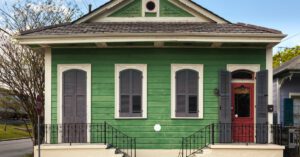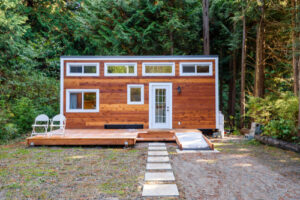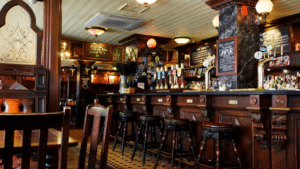Are you considering buying an old home? It can seem like a daunting task, especially if it’s your first home. Since we do a lot of work in downtown Guelph, we’re familiar with a lot of the common issues and questions that arise. So, we’ve decided to put together a list of 16 things to consider in old houses. There may be some deal breakers in this for you, but it’s better to know now that down the road!
Unlike new homes, inspecting an older home and major components of older homes are a much different task. Remember, older houses have been standing for 50 years or more!
The home could have had 10 different owners during that time and sometimes you’d be surprised (or not) about what you’d find. This table of contents will give you a categorized few of things to consider when buying an old home.
- Heritage status
- Insurance
- Foundation type
- Wiring
- Sump pump
- General Maintenance
- Previous renovations
- Lead Paint
- Asbestos
- Vermiculite
- Lack of insulation
- Termites
- Protected architecture
- Room sizes and layouts
- Furnaces vs boiler systems
- Old vs new construction
- Home inspection
Remember, when considering an older home you should consider a Guelph real estate agent who has experience with these types of homes. They know what to look out for and can advise home buyers on specific nuances within the area you’re searching.
Heritage status
Before you do any home renovations on an older home, your first stop should be to ensure that the home is not a heritage house. Unlike the United States, historical homes are far less than their National Register. These old buildings and historic homes have been here a long time and are protected on a municipal level, depending on the age of the home. These vintage homes could be protected for a variety of reasons, so it’s important to know what is protected to prevent potential issues down the road.
Specific to Guelph, there are many older homes that fall under two categories: A Designated Heritage home which means some elements are protected from being renovated, replaced or removed. The other category is the Historic Registry, which means there are no specific heritage elements that need to be protected, but you must still consult with the municipality to get approval if you plan to demolish the home.
The best way to determine if your home is considered on the list of historic sites is to contact your municipality, as each area is different. As an example, we just sold a home at 93 Nottingham St in Guelph that was historically designated. The designation was specific to the exterior architectural design, not the interior components.
Insurance
Your homeowners insurance company may have additional questions to ask you when you’re planning an old-house renovation. Older homes are made with materials that may be at, or near the end of their life span, or even dangerous by todays standards. These could include things like lead paint, or if there has been/ current is water damage or seepage in the basement (common in older homes). They’ll want the know the age of common elements like furnace, AC, wiring, plumbing, whether the house has a new roof etc. Be sure to ask your Guelph realtor about this.
Insurance companies may not cover you, or charge you a premium depending on a variety of factors.
Foundation type
Homes have gone through many types of foundation types: stone, concrete block, poured foundations and more. Basements are not meant to be finished as they were often damp. There are pros and cons to all types of foundation types throughout the years. If you wish to finish the basement of a century old home, be sure to consult with your contractor about the best materials and ways to do this. It may sound like finishing a basement to watch home movies is great, but if it gets damp and mouldy, it’s not enjoyable and could cause big problems down the road to the foundation.
Structural problems on an old property are something that should be somewhat obvious to the naked eye. Moisture in the basement, effervescence, step cracking are all potential structural issues. It’s worth noting that you can have a home with structural issues that will never prevent a future problem for you. However, they may cause future buyers to be wary.
Wiring
Knob and tube wiring
Early electrical systems in an old house included knob and tube wiring up until the late 1930’s and aluminum wiring from the mid 60’s until the late 1970’s. Although some would argue that left untouched these systems could still be safe, most insurance companies frown upon it.
If your home has knob and tube wiring, it’s quite likely your insurance company will deny you insurance, or give you a grace period (30-60 days) to have it removed and inspected by the Electrical Standard Authority (ESA). An easy way to determine knob and tube is to go into the basement and follow a few of the electrical lines that come out of the panel. Do they connect to a white cylindrical ceramic piece on the floor joist? If so, it could indicate existing knob and tube. This is something a home inspector could tell you.
Aluminum wiring
Although most home before and after the 1960’s have copper wiring, there was a period of time where homes have aluminum wiring. If your home was built in the 1960’s- mid 1970’s, it’s likely it was wired with aluminum wiring. As an older adult during that time, you’d likely remember it was due to a period of high copper prices. Although not an issue on it’s own and no expiration date, aluminum wiring doesn’t mix well with copper wiring and requires inspection by the ESA.
Aluminum wiring is relatively easy to spot: look at the writing coming out of the electrical panel. Written on it should be something like “aluminum” or a brand name such as “Aloomex”
Like knob and tube wiring, your insurance company may have an issue with aluminum wiring. The good news is that aluminum wiring is a lot less money to fix than knob and tube.
Sump pump
Century homes with basements that are dug out or made of stone or rubble foundation don’t usually have a sump pump like you’d find in newer homes.
The reason is because owners expected water to enter the basements in the old days. It was completely normal because basements weren’t actually used for much.
Sump pumps take excess water from a sump and pump it up and outside the home, preventing flooding. Should you have a sump pump? Read here to find out!
General maintenance
Buying an old house means you’re up for performing ongoing maintenance. You should be putting aside funds to deal with these issues and anticipate problems before they happen.
Some people update older homes over time to modern materials and finishes. However, others like to keep the original charm, for instance.
If you’re considering selling your home, you may want to read this article on best renovations before selling.
Previous renovations
On the flip side, you may be considering a century home that has had renovations done. Buying an old house that have been around for multiple generations likely have previous renovations- some good, some bad! But with old sometimes comes good discoveries. Under layers of that interior paint may be 100 year old beautiful wallpaper. Under old carpet you could find beautiful hardwood floors. A lot of people have been through a historical home. Some are higher quality than others or in configurations that are not ideal for you, as an example.
It could be that you need to undo what a previous owner has done in order to achieve the result you want. Consider this when preparing an offer.
Old windows
Many consider old wood historic windows to be superior to many of the vinyl windows that builders install on a newer house. Many old windows have removable storm windows that were added and taken out depending on the season. If your windows are old and drafty, it may be time to consider investing in new windows, which can be expensive.
Asbestos
Is asbestos safe? The word “asbestos” typically scares people buying an old house. Like lead-based paint, it’s one of these hazardous materials you want to ensure you’re aware of. However, it’s a great product that’s been around for many years and is often harmless if not disturbed.
You can find asbestos in vents, plaster, to wrap pipes for the plumbing system, ceiling tiles, flooring, exterior siding, plaster walls and even accidentally in some vermiculite insulation.
You’re not likely to find asbestos in homes built after the mid 1980’s. Again, doing your due diligence with a home inspection, this is something a home inspector could easily point out.
There is no average cost to remove asbestos, you should get a quote by an abatement company so that it can be tested and removed safely. We’ve had clients get quotes of $1000- $10,000.
Vermiculite
What is vermiculite insulation and do I need to get rid of it if I have it in my home? Not necessarily. You should test it to ensure there is no asbestos. You’ll most likely find vermiculite in attic insulation. Vermiculite alone is fine- it’s when there is asbestos that it becomes an issue to homeowners and insurance providers.
Lack of insulation
Double bricks on century homes were common (two layers of brick), but nothing in between that cavity. This of course isn’t great for energy efficiency, but in the olden days this was all they had. This means it gets colder quicker in the winter and your bills will increase.
There are many ways to address this though and sometimes the government offers incentive to offset the costs to homeowners, as an example.
Termites
These little bugs can be a big problem if they’re in your house. They can cause structural damage or re-sale problems down the road.
Talk to your municipality to get an idea if termites (or carpenter ants!) are in the area.
Protected architecture
In many downtown urban areas, you’ll find homes that have municipal protection due to their unique architecture. If you buy and old home with one of these designations, you can’t just demolish it and must maintain it in a specific way. As mentioned above, you should discuss options with your municipality before you begin an old-house restoration.
Room sizes and layouts of old homes
Homes in 1890, or even bungalows built in the 1950’s are different from homes today. Rooms tended to be more compartmentalized and had a specific purpose versus todays open floor plans. In fact, many older homes didn’t even have garage.
Modern amenities mixed with smaller rooms sometimes changes or limits the flow of a house. If you are removing walls to open up an older home, be sure your general contractor will consult with a structural engineer. Not only will it save your house from sagging or collapsing, it’s a vote of confidence down the road for a new buyer when you go to resell the home.
Click here to see what layouts looked like over the years!
Furnace vs boiler systems
Which is better, a furnace or boiler? In this blog post, we point out things to consider with each of these systems. From efficiencies to benefits and limitations. As an example: old radiators get hot, something that may be dangerous for children. Another consideration on a house with a boiler is the HVAC system doesn’t have ductwork on a boiler system. This HVAC system limits you from having central air conditioning and could be a deal breaker for some.
Old vs new house construction
The age old debate: do I buy the charm (and maybe problems) of old? Or, should I be buying a pre-construction home and some of the quirks that come a new build?
outline some of the pros and cons, check out buzzbuzzhome for lots of ongoing projects
Do I get a home inspection?
Where ever possible, it’s a good idea to get a home inspection. In this blog post, we go through some of the home inspections aspects.
It’s worth noting that home inspectors don’t get in depth on any specific item above, and only inspect what is visible. Home inspections are typically 3hrs in length and cost about $500.
Old homes can be a huge plus for some people but it’s not for everyone.
If you’re considering purchasing an old home in Guelph, get in touch!
We are Guelph real estate agents in Guelph and sell many homes in the downtown area of Guelph and would be happy to help.
Older homes are typically closer to amenities
Generally, older homes are closer and within walking distance to many amenities. Looking at Guelph specifically, older homes in the downtown areas are close to:
Pizza in Guelph
Examples of older homes
Here are some examples of older homes we’ve sold over the past few years:
63 Lyon Ave, Exhibition Park
13 Durham St, Downtown Guelph
57 St Arnaud St, Guelph Junction
93 Nottingham St, Downtown Guelph (designated heritage home)



